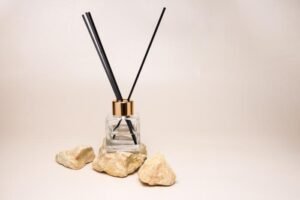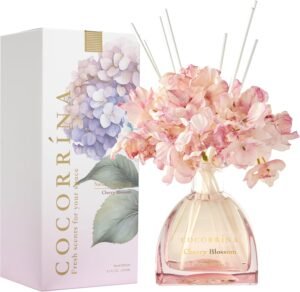Creating custom reed diffusers feels impossible when you’re overwhelmed by countless fragrance options and conflicting DIY tutorials online.
You can create your perfect custom reed diffuser using four essential components: carrier oils, essential oil blends, natural rattan reeds, and proper glass containers with correct oil ratios for optimal scent throw.
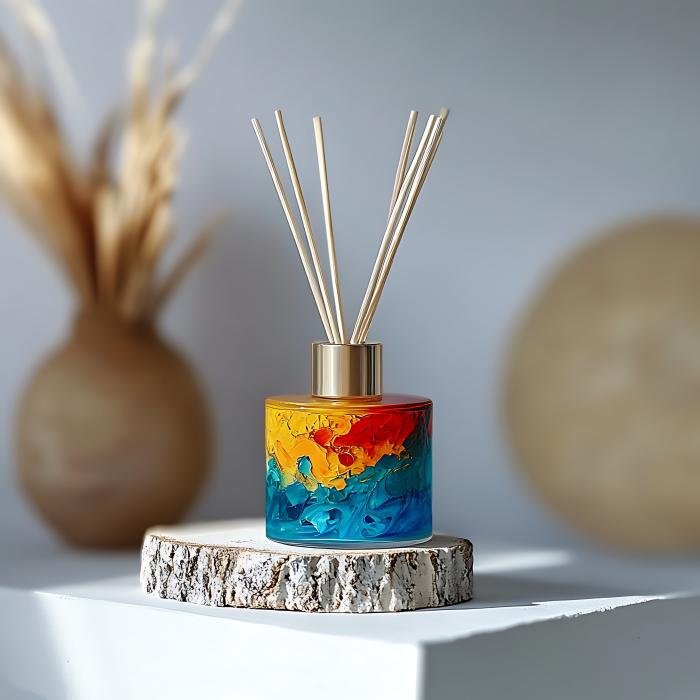
The growing popularity of personalized home fragrances reflects our desire for unique spaces that tell our stories through scent.
What Materials Do You Need for Your Custom Reed Diffuser?
Creating your own reed diffuser feels overwhelming when you’re staring at endless supply lists. The confusion grows as you wonder which materials truly matter for success.
You need four essential components: diffuser base oils (carrier oil), essential oil blends, quality diffuser reeds, and dye-free bottles. These materials work together to create long-lasting, beautiful fragrance distribution throughout your space.
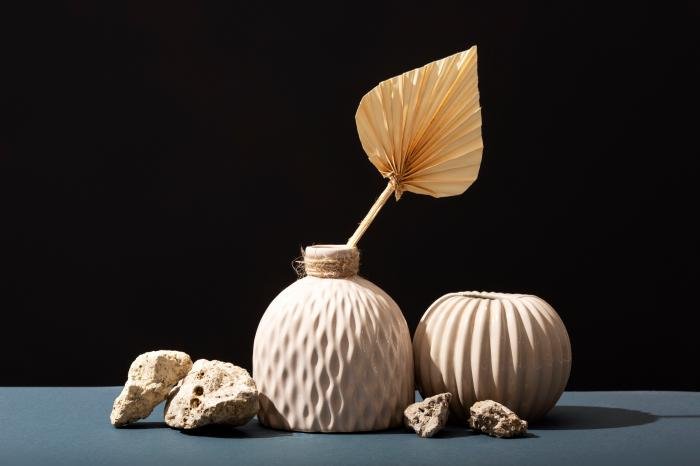
Essential Base Components for Success
The foundation of any effective reed diffuser starts with selecting the right diffuser base oils. Sweet almond oil and fractionated coconut oil rank among the top choices for their excellent wicking properties. These carrier oil options maintain consistent viscosity while preventing reed clogging. Safflower and grapeseed oils offer budget-friendly alternatives without compromising performance.
Your container selection significantly impacts both safety and aesthetics. Dye-free bottles prevent color bleeding that can stain surfaces and compromise oil integrity. Glass containers work best because they’re non-reactive and maintain oil purity. Choose bottles with narrow necks to slow evaporation while ensuring proper reed placement.
Quality Reeds and Safety Considerations
Natural rattan reeds outperform synthetic alternatives in fragrance throw and longevity. These porous sticks draw oil upward through tiny channels, creating consistent scent release. Replace reeds every 4-6 weeks to maintain optimal performance, especially when switching between different essential oil blends.
Safety remains paramount when assembling your DIY supplies. Store materials away from direct sunlight and heat sources. Always use allergen-free formulations when possible, particularly for commercial applications. Loveeno’s curated material selection emphasizes organic ingredients and rigorous testing standards, ensuring your custom creations meet both performance and safety requirements.
| Material Type | Best Options | Principais benefícios |
|---|---|---|
| Óleo veicular | Sweet Almond, Fractionated Coconut | Excellent wicking, stable viscosity |
| Contentor | Clear glass, narrow neck | Non-reactive, controlled evaporation |
| Reeds | Natural rattan | Superior fragrance throw |
| Óleos essenciais | Pure, allergen-tested | Safe, long-lasting scent |
How Can You Create the Perfect Base Formula for Your Diffuser?
Creating a custom reed diffuser base feels overwhelming when you’re staring at dozens of carrier oils, unsure which ratios will deliver optimal scent throw without compromising safety.
The perfect diffuser formula combines 70-80% light carrier oil with 20-25% fragrance concentration, using alcohol or dipropylene glycol to enhance scent dispersion and reed absorption.
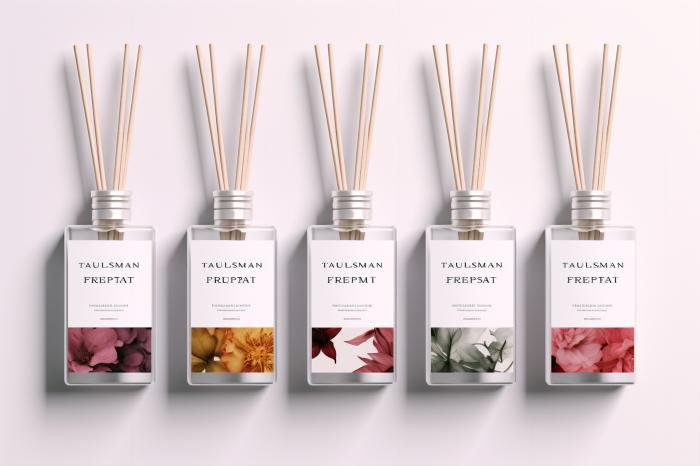
Understanding Carrier Oil Ratios
Light carrier oils form the foundation of any effective custom reed diffuser base. Safflower and sweet almond oils work exceptionally well due to their thin consistency and room-temperature fluidity. These oils travel up reeds efficiently, ensuring consistent fragrance release throughout your space.
The key lies in maintaining proper viscosity. Heavy oils like jojoba create absorption problems since they solidify at room temperature. Your DIY base mix should flow freely while carrying fragrance molecules effectively. Loveeno’s small-batch mixing approach ensures each carrier oil maintains optimal consistency for professional-grade performance.
Optimizing Fragrance Concentration
Scent throw depends heavily on your fragrance concentration ratios. Most successful formulations use 20-25% fragrance oil maximum, though some delicate scents perform better at 15%. Testing different concentrations helps you find the sweet spot between longevity and intensity.
| Componente de base | Faixa Percentual | Função principal |
|---|---|---|
| Óleo veicular | 70-80% | Reed absorption, scent transport |
| Óleo de fragrância | 15-25% | Scent intensity, throw distance |
| Alcohol/DPG | 5-10% | Enhanced dispersion, evaporation |
Consider allergen awareness when selecting fragrance levels. Higher concentrations increase sensitivity risks, especially in enclosed spaces. Start with lower ratios and gradually increase until you achieve desired scent throw without overwhelming the environment.
Which Essential Oil Combinations Create Unique Scent Profiles?
Creating custom scent profiles requires strategic oil pairing, safety awareness, and allergenic considerations that overwhelm beginners.
Essential oil combinations create unique scent profiles through layering top notes (citrus, herbs), middle notes (florals, spices), and base notes (woods, resins) in balanced 30:50:20 ratios. Successful fragrance blending considers molecular compatibility and evaporation rates.
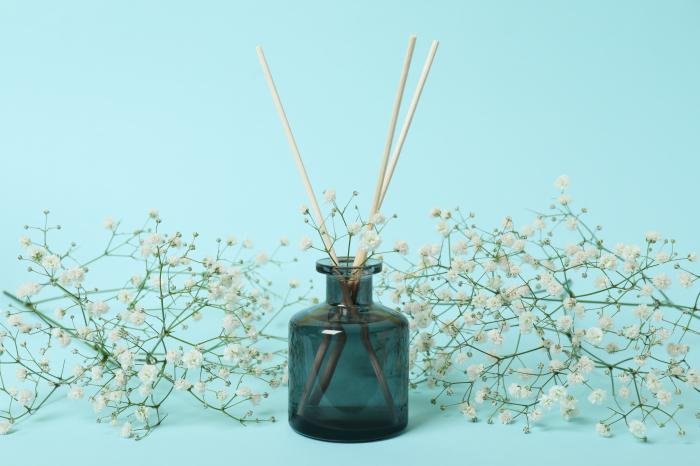
Understanding Note Structure for Custom Scent Profiles
The foundation of successful essential oil blends lies in understanding fragrance architecture. Top notes provide the initial impression, lasting 15-30 minutes with citrus oils like bergamot and lemon leading the composition. Middle notes form the heart, persisting 2-4 hours with lavender, geranium, and eucalyptus creating emotional depth. Base notes anchor the blend for 6+ hours using sandalwood, patchouli, or cedarwood.
Professional blenders follow the 30:50:20 ratio as a starting framework. This translates to 3 drops top notes, 5 drops middle notes, and 2 drops base notes per 10-drop blend. However, natural diffuser oils require adjustments based on intensity and personal preference.
Safety Standards and Allergen Considerations
Loveeno emphasizes allergen awareness in small-batch mixing processes. Common sensitizers include citral (lemongrass), limonene (citrus oils), and linalool (lavender). Always perform patch tests before creating larger batches. Dilution rates should never exceed 1-3% for topical applications, while diffusion blends can use higher concentrations.
| Blend Category | Top Note Example | Middle Note Example | Base Note Example | Considerações de segurança |
|---|---|---|---|---|
| Fresh Citrus | Sweet Orange | Lavanda | Sândalo | Monitor citrus photosensitivity |
| Woodsy Earth | Bergamota | Alecrim | Cedarwood | Patch test rosemary sensitivity |
| Floral Romance | Limão | Rose Geranium | Patchouli | Check rose allergens |
| Spicy Warm | Toranja | Casca de canela | Baunilha | Dilute cinnamon properly |
Kit packaging ensures shipping safety through leak-proof containers and temperature-controlled delivery systems. This protects blend integrity while maintaining therapeutic properties throughout the supply chain.
What Are the Best Assembly Techniques for Long-lasting Diffusers?
Poor diffuser assembly leads to weak scent throw and rapid oil depletion. Many DIY enthusiasts struggle with creating diffusers that maintain consistent fragrance intensity.
The best assembly techniques involve selecting narrow-opening containers, using proper oil ratios of 20-30% fragrance oil to carrier oil, and strategic reed placement for optimal scent control and longevity.

Container Selection and Reed Preparation
Proper diffuser assembly begins with choosing the right container and preparing quality reeds. Narrow-opening vessels significantly reduce evaporation rates, extending your diffuser’s lifespan by 30-50%. Glass containers work best as they don’t absorb fragrance oils, maintaining scent purity throughout use.
Reed preparation involves selecting natural rattan sticks over synthetic alternatives. Trim reeds to appropriate lengths – typically 6-8 inches above the oil line for optimal diffusion. At Loveeno, we recommend testing reed porosity by placing them in water first; quality reeds should wick liquid within minutes.
Oil Blending and Scent Intensity Control
The foundation of long-lasting diffusers lies in proper oil ratios and blending techniques. A 20-30% fragrance oil concentration provides the ideal balance between scent throw and longevity. Heavier carrier oils like sweet almond or fractionated coconut oil slow evaporation while maintaining excellent scent diffusion.
| Assembly Component | Rácio recomendado | Impacto na longevidade |
|---|---|---|
| Óleo de fragrância | 20-30% | High scent intensity |
| Óleo veicular | 70-80% | Extended diffusion time |
| Contagem de canas | 3-6 sticks | Customizable scent strength |
| Container Opening | 1-2 inch diameter | 40% longer lasting |
For scent intensity control, adjust the number of reeds rather than oil concentration. Start with 3-4 reeds and add more gradually. This approach maintains oil balance while allowing customization. Remember that organic ingredients require careful allergen documentation, especially when creating products for sensitive users.
How to Customize Your Reed Diffuser’s Appearance to Match Your Décor?
Plain diffuser bottles clash with carefully curated interiors. Generic containers disrupt your design vision. Transform ordinary vessels into decorative statement pieces that complement your aesthetic.
Customize your diffuser’s appearance through bottle selection, decorative labels, color coordination, and seasonal styling. Choose containers that match your décor style, add personalized elements, and create cohesive visual harmony with existing furnishings.

Choosing the Right Custom Diffuser Bottles
The foundation of aesthetic customization starts with selecting appropriate containers. Glass bottles offer versatility for various décor styles, from minimalist clear vessels for modern spaces to colored glass for vintage themes. Consider bottle shapes that echo your room’s design elements – cylindrical for contemporary settings, ornate for traditional spaces.
Decorative reed diffuser options extend beyond basic glass. Ceramic vessels suit rustic or farmhouse aesthetics, while metal containers complement industrial designs. Size matters for visual balance; larger rooms accommodate bigger bottles, while smaller spaces benefit from petite vessels that don’t overwhelm.
DIY Container Ideas for Personalized Design
Transform everyday objects into unique fragrance vessels through creative repurposing. Wine bottles offer elegant silhouettes perfect for sophisticated spaces, while mason jars provide charming rustic appeal. Clean thoroughly and ensure proper reed compatibility before converting any container.
| Tipo de contentor | Best Décor Style | Customization Ideas | Nível de dificuldade |
|---|---|---|---|
| Glass Wine Bottles | Moderno, Minimalista | Etching, Rope Wrapping | Iniciante |
| Mason Jars | Farmhouse, Rustic | Burlap, Lace, Paint | Easy |
| Vasos cerâmicos | Traditional, Bohemian | Decoupage, Stencils | Intermediário |
| Apothecary Bottles | Vintage, Industrial | Labels, Metal Accents | Iniciante |
Home Décor Matching Strategies
Coordinate your diffuser with existing color schemes and textures. Match bottle colors to accent pieces like throw pillows or artwork for cohesive styling. Consider seasonal rotations – warm autumn tones transitioning to cool winter hues – to maintain fresh visual interest throughout the year.
Loveeno’s small-batch mixing approach allows precise color matching for custom oils, ensuring both fragrance and appearance align with your décor vision. This attention to aesthetic detail creates personalized fragrance gifts that truly reflect individual style preferences.
Conclusão
Creating your perfect custom reed diffuser transforms your living space into a personalized sanctuary through carefully selected carrier oils, balanced essential oil blends, quality rattan reeds, and proper assembly techniques. By mastering DIY reed diffuser fundamentals—from understanding fragrance note structures to optimizing scent throw ratios—you gain complete control over your home’s aromatic atmosphere. Start your handcrafted diffuser journey today by gathering basic materials and experimenting with essential oil blends that reflect your unique style preferences.
FAQ
Q1: What is the best carrier oil for a custom reed diffuser?
Fractionated coconut oil or safflower oil are excellent choices for reed diffusers due to their light texture and ability to disperse fragrance oils effectively. Avoid heavy oils like olive oil, as they can clog the reeds.
Q2: How can I layer scents in a custom reed diffuser?
To layer scents, start with a base note (e.g., vanilla or sandalwood), add a middle note (e.g., lavender or rose), and finish with a top note (e.g., citrus or mint). Experiment with small batches to find your perfect blend.
Q3: Are dye-free bottles better for reed diffusers?
Yes, dye-free bottles prevent unwanted chemical interactions with your fragrance oils and maintain the purity of your scent. They also offer a minimalist aesthetic, which is popular among DIY enthusiasts.
Q4: Where can I source high-quality reeds for my DIY diffuser?
Look for natural rattan reeds from reputable suppliers like Aroma Lab or specialty candle-making stores. Ensure the reeds are porous and untreated for optimal fragrance diffusion.
Q5: How do I ensure my custom reed diffuser is safe for shipping?
Use leak-proof, dye-free bottles and secure the reeds separately to prevent breakage. Wrap the diffuser in bubble wrap and label it as fragile to ensure safe delivery.


